 Introduction
Introduction
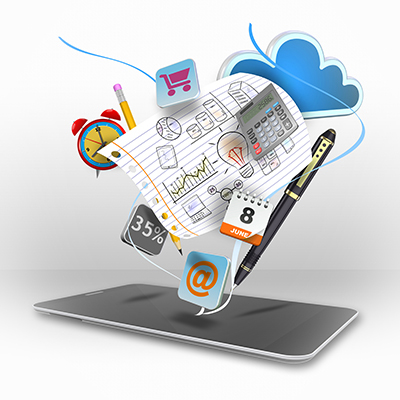
A GES (Gainful Employment Score) can be reliably calculated only for college graduates with job roles in businesses medium-size and higher. There are two main reasons for this. First, significant gains in skills and available opportunities to advance careerwise are mainly for college graduates. Second, only businesses of a certain size are organized around a process structure which distinguishes between various basic functions. In smaller businesses the lines between different roles are usually blurred.
The biggest challenge when calculating a job seeker score is in accounting for a wide variety of job roles, type of tasks, business models, and workplaces. Our approach is to use a single baseline model for all the businesses, and capture the variety using only four basic business models. However, there are organizations in the socio-economic realm which do not fit in this framework. They are the government organizations and the investement firms. While they may have in common key economic drivers such as efficiency, or be structured in a similar way (i.e. they have Operations, Executive Leadership, HR, financial, etc functions), their fundamental business model is not organized around the relationship producer-consumer.
Extending this approach to businesses poses many challenges. Assessing using a simple score an overall business (Business Gainful Employment Score) requires a deep understanding of how various functions are coming into place. In the end, a scoring mechanism can be considered accurate only if it can predicts how successful a business is in attracting consumers and create profits from that relationship.
To create the baseline model for our scoring methodology, we are using a new approach called Adaptive Engineering. The focus is on change, as we consider the source of all the complexities related to business operations, and the target of management. Viewing the business as a viable, adaptive system has been ackowledged since 50s.
Business, as a Complex Adaptive Systems
Viability and complexity are the two main drivers in how a business is organized and managed. The resulting structure is the basis for our scoring framework.
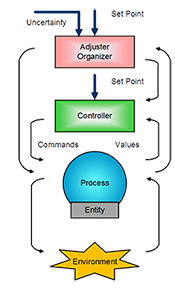
Stafford Beer is one of the first that recognized viability, expressed as the ability to adapt to an uncertain input from environment, as the most important characteristic of a business. A basic adaptive open model built around an entity has two elements: controller and the controlled process. Long term viability is made possible only if the controller is able to anticipate various uncertain scenario and integrate a response to them in the long term planning for its operations. As a result, in an entity lifecycle there are three main types of processes an adaptive system uses to handle uncertainty: forecast, plan, and execute acording to the plan. It is obvious that a member of a business needs to be first familiar with the main process before it can design various scenarios that will adapt that process to handle uncertain events.
The second most important characteristic is the complexity of processed information. This can be expressed using a simple scale. The wider the range of options information has, the higher the complexity of processes needed to handle it. For instance, forecasting is higher in complexity than execution. As a result, a standard career path needs to start from simpler tasks, as those found in core operations, towards more complicated ones, as planning and forecasting.
GES Scoring Framework
The model that drives the scoring starts at the macro-economic level, and ends up with a standardized detailed map of all the business functions. To note that a business function is not necessarily the same with the way businesses are physically organized.
Socio-Economic Realm - Macro Layers
At the macroeconomic view, all main relationships can be represented by only layers: government, investors, business, and consumer.
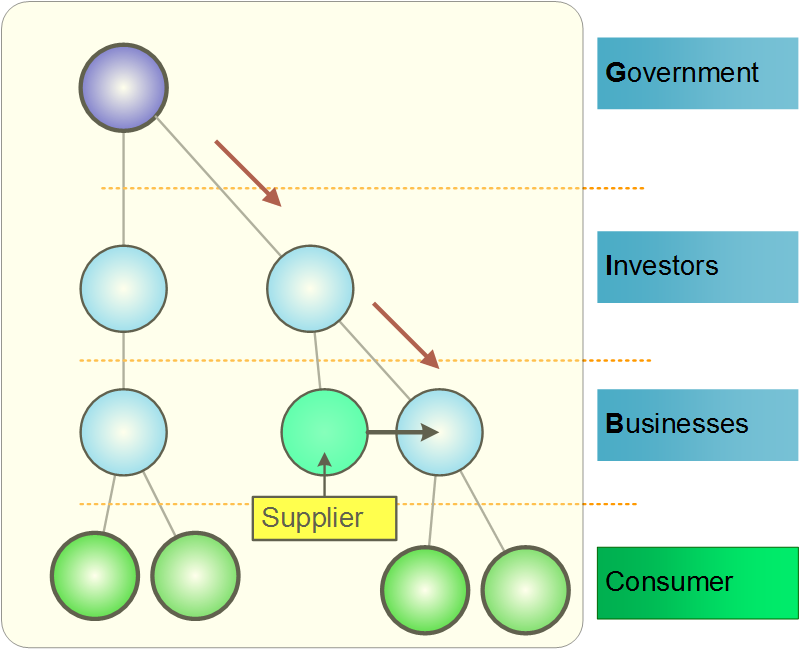
Socio-Economic Realm
Controlling Hierarchies
In the socio-economic realm, government is at the top of the controlling hierarchy. Ownership is repesented by the investment layer. Businesses are the main engine of our society. The relationship between investors and businesses is tightly regulated. The goal is to strike a balanced approach between long term ownership goal and short term business cycles. Our focus is the business-consumer relationship.
How it works: business 'controls' the relationship with consumer through products and services. Consumer 'feedback' is acting on its ability to select a product/service that suits better his/her needs.
Business and Consumer
At the macroeconomic level, businesses and consumers cannot be separated. All internal business cycles include a consumer need as a target.
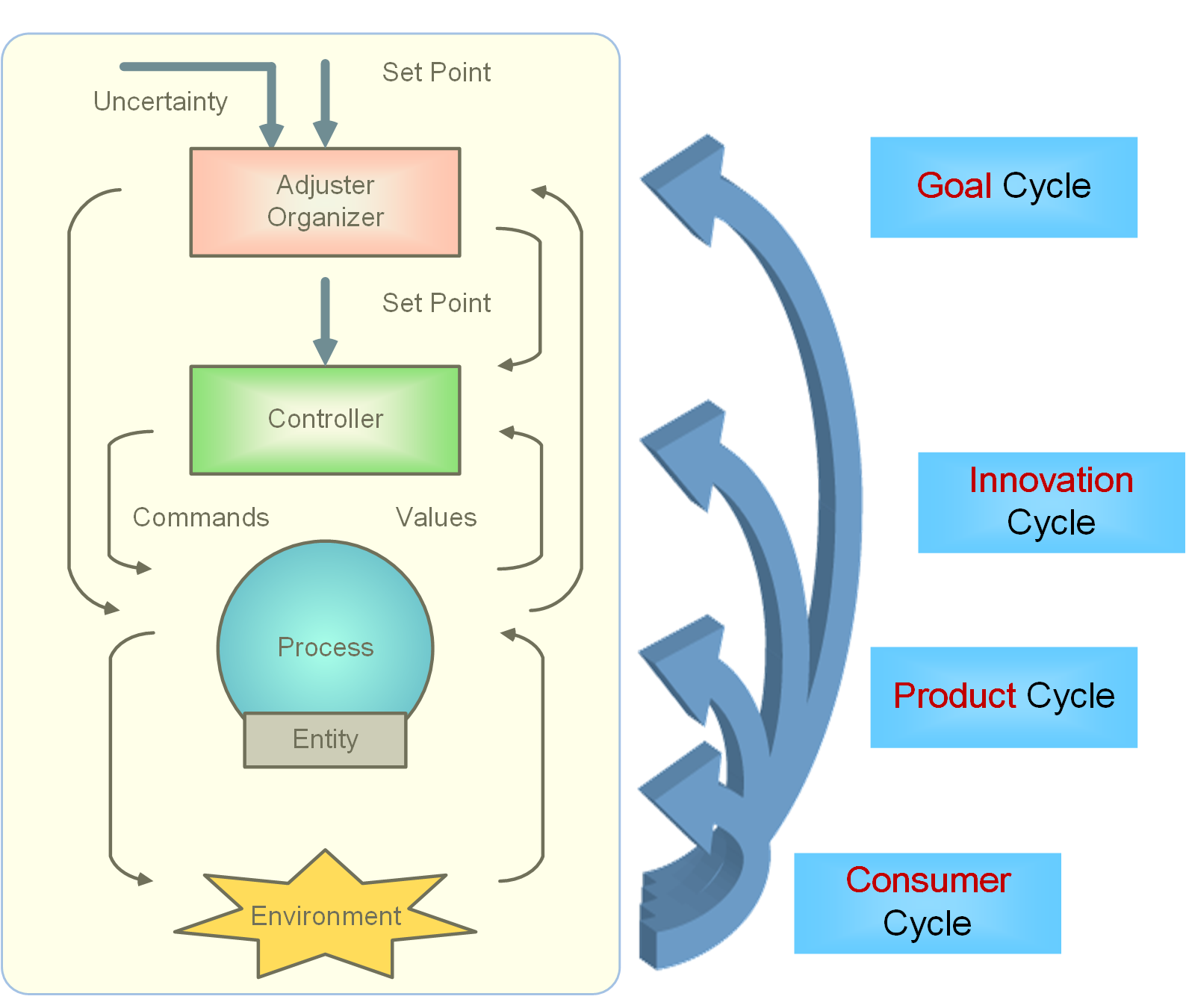
Business Cycles
Core Business Cycles
Each business has two types of core activities: Operations and Management. Operations revolve around the value chain, and Management revolves around Change Management. These main cycles can be mapped to Stafford Beer's Viable System Model. They are:
- Consumer Cycle - this cycle has its steps built around the direct sale of a product/service
- Product Cycle - this cycle has its steps built around the value chain (add value)
- Innovation Cycle - this cycle has its steps built around the development of new products/services
- Goal Oriented Cycle - this cycle sets the goals for all the previous ones
How it works: company's goals drive the development of new products/services. Once development cycle is complete, company's operations are adapted to the new product/service. The outcome is the sale to consumer.
High Level Structure
All business functions can be split in two categories: core and service-like support. Each one of them can be split further into five business areas.
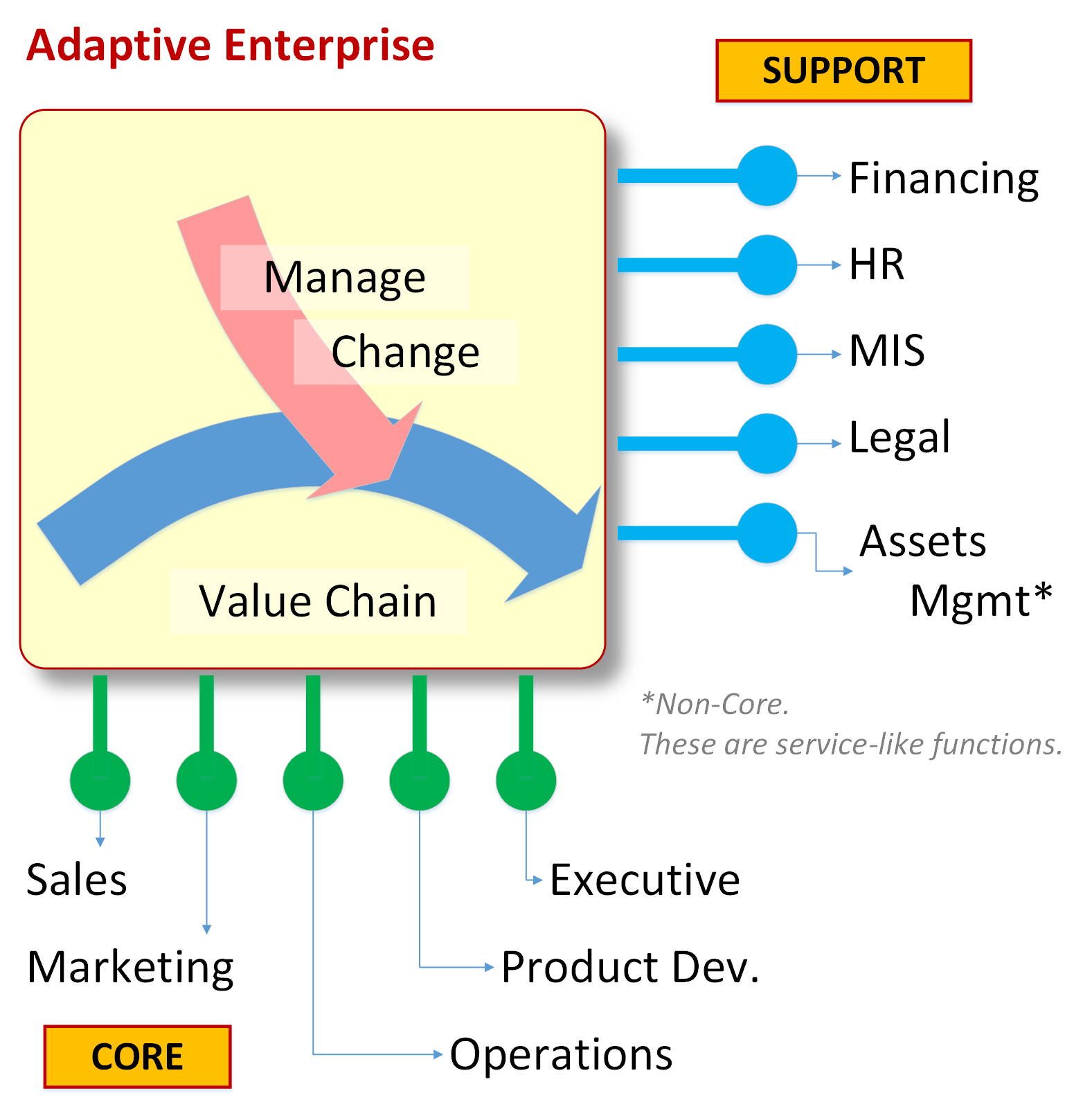
Core vs. Support
Core Business Areas
Main core functions are grouped in five areas:
- Sales - its role is to provide finished goods and services to consumers
- Marketing - its role is to manage the communication between business and its consumer audience
- Operations - its role is to manage the value chain; value chain is a set of activities performed in order to deliver products and services to the market.
- New Product Development - its role is to translate a market opportunity into a product or service for sale
- Executive Leadership - its role is to govern the business, represent it to investors, formulate its corporate strategy; it represents the 'face' of the business to the socio-economic realm
Support Business Functions
Main service-like support functions are also grouped in five areas:
- Financing - its role is to manage financial resources
- Human Resources - its role is to manage the relationship between employees and business
- Management Information Systems - its role is to manage the entire lifecycle for information systems used to support business functions
- Non-Core Assets Management - its role is to manage non-core assets (not used directly in the value chain)
- Legal Counsel - its role is to manage the legal context in which a business operate
This grouping in areas is used to build a unified model of the business and associate levels of complexity. A job seeker performing tasks associated with functions of higher complexity it is assumed to have a higher score, and as a consequence will be easier to be promoted, or change companies.
Unified Model
We represent the relationship between core and support areas with a model called Adaptive Enterprise Operations Platform (AEOP). We use this framework, which captures the adaptive nature of the business, as the foundational element for all our scoring workflow. Using complexity as a guideline, we can identify five layers for all business function. Each layer can be split furtther to capture the relationship with the business cycles.
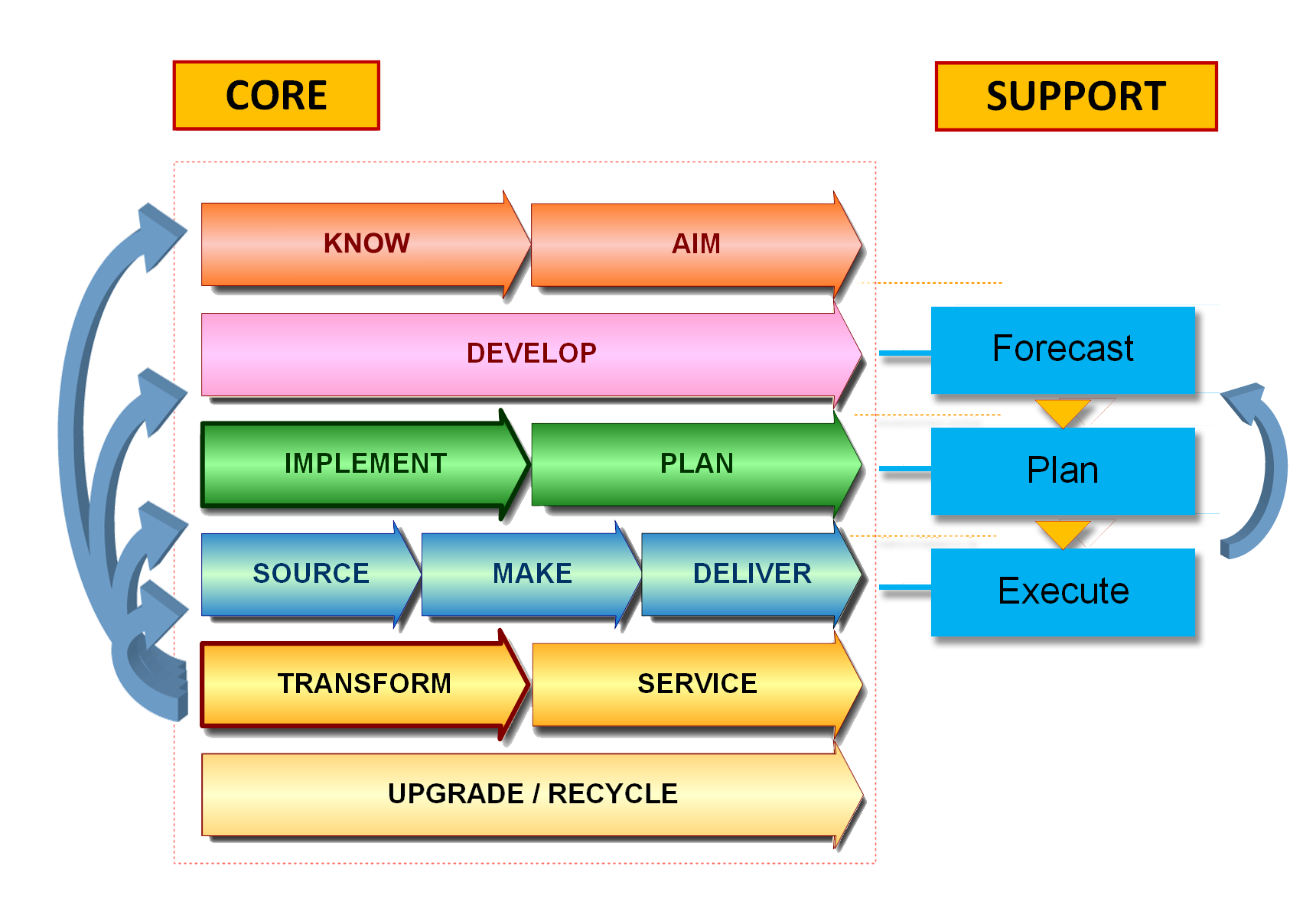
Classes of processes (levels of complexity):
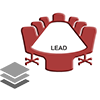 Executive Leadership Process Class (highest complexity)
Executive Leadership Process Class (highest complexity)
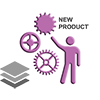 New Product Development Process Class
New Product Development Process Class
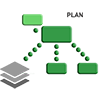 Planning Process Class
Planning Process Class
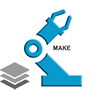 Make Process Class (Operations)
Make Process Class (Operations)
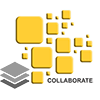 Collaboration Process Class (both Supply and Deliver)
Collaboration Process Class (both Supply and Deliver)
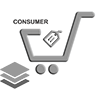 Consumer Process Class (Operations)
Consumer Process Class (Operations)
Adaptive Reference Model
Unified Model of the Business
As mentioned previously, there are two types of business functions: core and support. They are part of foundational business cycles. Following are their main steps:
Core Cycles Steps:
All four cycles in a business can be represented in a unified structure. Next are the main steps of this unified model:
- Know - Processes that establish two fundamental models based on which business target a sustainable, successful operations which deliver value to its customers. First it is the foundational business model, which is the blueprint by which the business operates. Second is the predicted model of the consumer needs. They are used as guidelines for new products or service features.
- Aim - Processes that capture how executive leadership establishes goals and directions using the business model as a blueprint, marketing forecast, and input from their board (represnting investors).
- Develop - Processes that describes the steps taken to develop new products and services.
- Implement - Processes that translates new product or service specifications into requirements for the changes to business value chain (production). The maturity of these processes are directly related to the ability of a business to adapt their operations to delivering new products and services.
- Plan - Processes that balance demand and supply to develop a course of action which best meets sourcing, production, and delivery requirements. They revolve around master scheduling.
- Source - Processes that procure goods and services to meet planned or actual demand
- Make - Processes that transform product to a finished state to meet planned or actual demand. They form the value chain.
- Deliver - Processes that provide finished goods and services to meet planned or actual demand. They include order management, transportation management, and distribution management.
- Transform - Processes associated with a sale, that describes the steps taken by a consumer to adapt to a new product or service provided by business. These processes are directly related to the ability of a consumer to change his/her behaviour as a result of acquiring a new product or use a new service.
- Service - Processes associated with servicing goods owned by consumer after the sale.
- Upgrade/Recycle - Processes associated with the end of a lifecycle of a product owned by a consumer.
Support Cycle Steps:
For service-like functions, there is only one simplified cycle with three steps. They are always aligned with the core unified structure. These steps are:
- Forecast - Processes associated with formulating a model that aligns to the main operational goals. From this model, service-like support functions leadership creates a set of requirements for change.
- Plan - Processes associated with translating the previous set of requirements into practical steps. They will become part of the master scheduling.
- Execution - Processes associated with supporting the product transformation.
How it works: Once the overall strategy for core operations is formulated by the executive leadership, the next step is to identify the steps needed to align the service-like processes strategy to the major goals. These service-like support processes are: Financing, Human Resource Management, Management Information Systems, Non-Core Assets Management, and Corporate Legal Counsel. The simplified cycle starts with formulated a forecast of how a service-like function can help the main operations. This process 'resides' on the same level with 'Develop'. Both, 'product development' and 'forecast' for service-like functions, are using a 'portfolio' as input and have 'requirements' as output. Next step is 'planning'. It takes previous 'requirements' and translates them into practical steps. The final step is 'execution'. This is where both value chain type operations and service-like support are synchronizing their efforts in delivering value to consumers.
Foundational Business Models
Each one of the four business cycles requires a different strategy. As a result, a business always picks a strategy and aligns all the resources and operations behind it. So we end up with only four fundamental business models. To note that government organizations and investement firms are not covered by these business models.
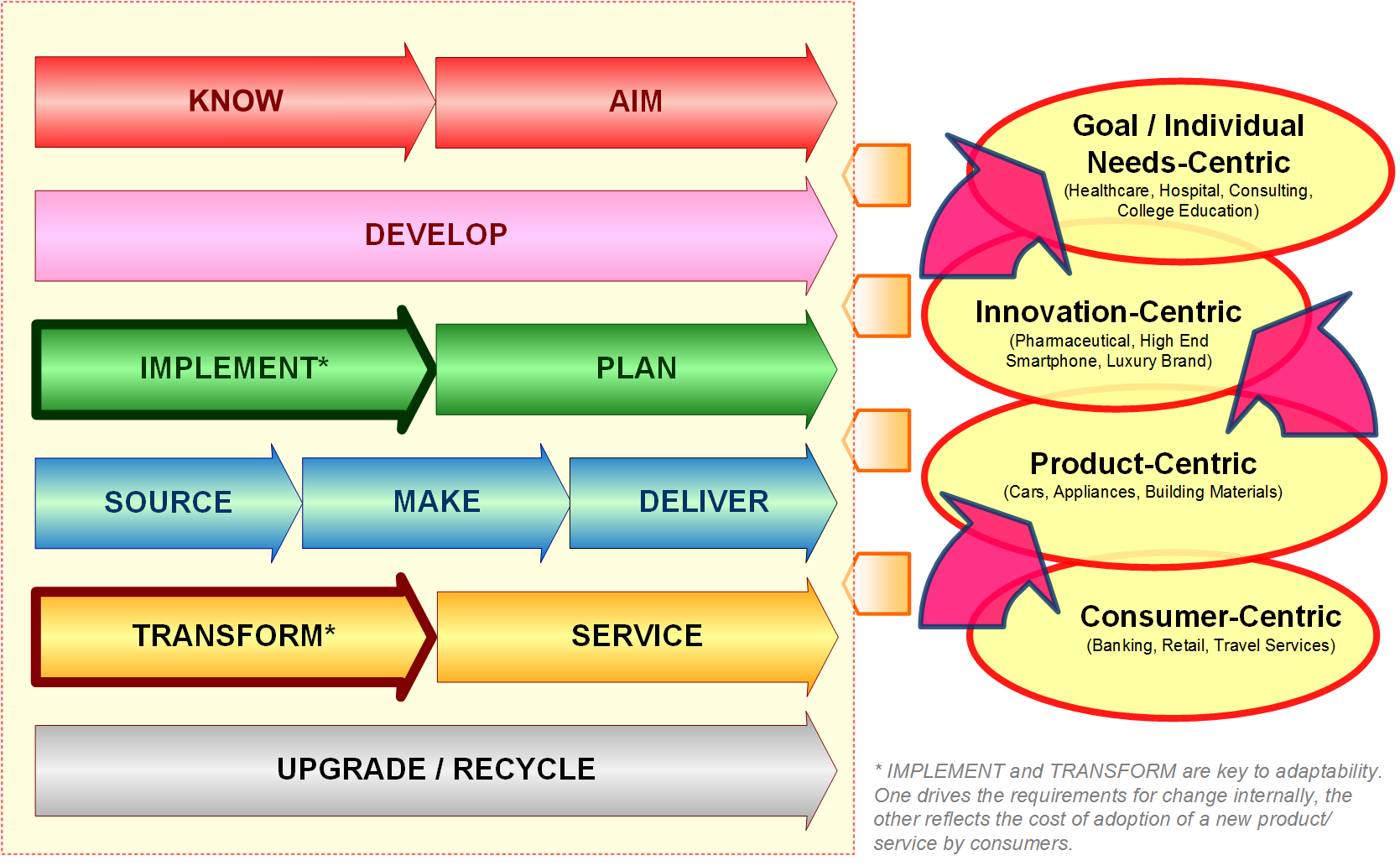
Business Models
From Consumer Centric to Individual Needs
Classes of business models (based on levels of complexity):
 Goal/Individual Needs-Centric Model - this is the highest complexity type of business.
it organizes the entire operations ideally around each individual consumer.
Types of businesses: hsopitals, colleges, and consulting.
Goal/Individual Needs-Centric Model - this is the highest complexity type of business.
it organizes the entire operations ideally around each individual consumer.
Types of businesses: hsopitals, colleges, and consulting.
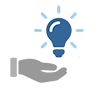 Innovation-Centric Model - the target of this type of business model are products
with features for which consumers are willing to pay a premium.
Processes like manufacturing or selling are secondary. Type of businesses: pharma, high-end smartphones manufacturers,
defense systems.
Innovation-Centric Model - the target of this type of business model are products
with features for which consumers are willing to pay a premium.
Processes like manufacturing or selling are secondary. Type of businesses: pharma, high-end smartphones manufacturers,
defense systems.
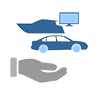 Product-Centric Model - this is the most widespread business model and the one that drives most
of the socio-economic mechanism. Focus is mainly on an efficient value chain operations. New features
can be added but not expected to drive prices too high. For these type of products,
consumer is cost-conscious. Type of businesses: car and appliance manufacturers.
Product-Centric Model - this is the most widespread business model and the one that drives most
of the socio-economic mechanism. Focus is mainly on an efficient value chain operations. New features
can be added but not expected to drive prices too high. For these type of products,
consumer is cost-conscious. Type of businesses: car and appliance manufacturers.
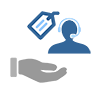 Consumer-Centric Model - this types of business model optimizes processes around delivering goods to consumers.
Type of businesses: retail, travel services, dealerships.
Consumer-Centric Model - this types of business model optimizes processes around delivering goods to consumers.
Type of businesses: retail, travel services, dealerships.
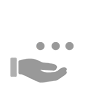 Other Models - while the first four models cover most of the traditional businesses,
there are few exceptions. Organizations such as non-profit, museums, sports and entertainement,
may have their main processes organized around operations which may cover only few steps of those four cycles.
Other Models - while the first four models cover most of the traditional businesses,
there are few exceptions. Organizations such as non-profit, museums, sports and entertainement,
may have their main processes organized around operations which may cover only few steps of those four cycles.
There are also few business models which do not match entirely one of the four cycles. One example is of a business based on customized products. Examples: print shops, ship building. However, they can be identified as having a product-centric business model, as their focus is operational efficiency. Customization is expected to be covered only by a modest increase in price.
Short Summary of GES, TGES, GGES, and BGCS
This grading system applies to job seeker that have their career goals linked to traditional business models. The score is calculated based on models which have a stated goal to create a scale in complexity for various business functions and information systems (architecture, implementation).
It does not apply to career paths in government or investing field. This is true partially also for college students chosing a career in government, or in investment. Our goal is to add functional models for those fields in the near future if there are enough requests.
Gainful Employment Score (GES) for Business Roles
- Definition: measures job seeker ability to cope with change (Operative) or drive change (Manager)
- Applies: job seekers from all business roles (except Information Systems)
-
Business Roles:
Operative: Entry Level, Operative, Senior Operative, Project Manager
Management: Team Lead, Manager, Departement Manager, VP, C-Level, CEO
-
Major Career Paths:
Core: Sales (VP of Sales), Marketing (CMO), Operations (COO), Product Development (CTO), Top Leader (CEO)
Support: Financing (CFO), Human Resources (VP of HR) Management Information Systems (CIO), Assets Management (Non-Core Assets such as Facilities, etc.) Legal (Corporate Legal Counsel)
- Measures: O - operative skills M - management skills
- Factors used in calculation: business context in which job role, tasks associated with job role, and personal achievements
- Values: two values - 0 to 1000
-
Class ratings (per business cycle):
Consumer cycle:0 to 200Product cycle:200 to 550Innovation cycle:550 to 700Goal/Individual Needs cycle:700 to 1000 -
Group ratings for each class calculated as percentage:
Poor:0 to 25 %Fair:25 to 45 %Good:45 to 80 %Excellent:80 to 100 %
Score assessment: past role interact with customer, currently manager in core operations(make, deliver, source)
For an experience in a business function to be counted with maximum points, a job seeker has to participate in at least three full cycles of the main business model. For instance, in product-centric businesses, a cycle is usually counted as a main revision/update to a product. For innovation-based business model, a full cycle is usually counted as one year as most of the businesses make major updates every year. There are exceptions to this in industries such as pharma, management consulting, health care. For consumer-cycle based business models, higher score can be achieved when job seeker experienced a major positive change in market share.
Techonology Gainful Employment Score (TGES) for IT Professionals
- Definition: This score measures job seeker ability to cope with changes in traditional business roles and in either one of the two IT areas of a business. First area is the developing of software as a product or part of a product, and the second area is part of the business MIS. For traditional business role (Operations and Management), a job seeker is measured using the same criteria used in GES for business roles. To these scores we add the cadidate skills in IT. We measure those skills accross two dimensions: application lifecycle complexity and enterprise applications (a combination of how complex the different types of components are and the complexity of targeted business function).
- Applies: job seekers working with software (business IS or product software)
-
Information Systems And Developer Roles:
Operative: Entry Level, Operative (Support, Development, QA, etc.), Senior Operative, Project Manager
Manager: Team Lead, Manager (DevOps, Development, etc.), Architect, Enterprise Architect, CIO
-
Major Career Paths:
Management: Product/Product Line Owner (for software companies or products with extensive software/hardware components), Enterprise Architecture (Chief Architect), Management Information Systems (CIO)
- Measures: O - operative skills M - management skills TC - programming skills TE - ability to design, build, deploy, and maintain business information systems
- Factors used in calculation: in addition to O and M, the T component has two scores: TC is directly related to the complexity of the application a job seeker has experience with, and TE captures the relationship between the same application and the complexity of the business function it automates
- Values: four values - 0 to 1000
-
Class score ratings for TC:
Web-Based Client Platform: (i.e. for internal business apps using Javascript, CSS, HTML5)0 to 100Server-Based Platform: (i.e. Web server, RMI, IOT)100 to 200Web-Based Client/Web-Based Server Platform: (i.e. Full-stack apps, Online Sales, CRM)200 to 300Web-Based Client/Cloud-Based Server Platform: (i.e. Salesforce, ERP)300 to 400Native Application Platform: (i.e. Word, Photoshop, IDE, Databases, Search Engines, Cloud Platforms, OS - Linux, Windows)400 to 600Native Client/Custom Server Platform: (i.e. Integrated Remote Systems, UAV integrated platforms for Global Hawk, Predator)600 to 800Real-Time Native Client/Custom Server Platform: (i.e. Integrated Robotic Systems for Assembly Lines)800 to 1000 -
Class score ratings for TE:
Transactional Engine-Based Platform: (i.e. Online Sales)0 to 200Collaborative System-Based Platform: (i.e. Supply Collaboration Plaform)200 to 350Business Function Centric Platform: (i.e. Sales, CRM, MRP)350 to 500Cross-Functional Enterprise Platform: (i.e. ERP + CRM + MRP + Finance +...)500 to 700Model-Driven Enterprise Platform:700 to 850Adaptive Enterprise Operational Platform:850 to 1000 -
Group ratings for each class calculated as percentage:
Poor:0 to 25 %Fair:25 to 45 %Good:45 to 80 %Excellent:80 to 100 %
Note: There is a difference in points between building internal business applications and when these are part of a product. In the second case the score is much higher because it is core component of a value chain cycle. In that case, even applications that have their logic embedded in mostly Javascript, can get a much higher score.
Score assessment: past role in MIS operations (support, maintain enterprise applications, DevOps, etc), now in role of CIO, past experience in developing native applications, and in the enterprise application space, expertise in collaborative platforms (i.e. similar to message-based banking).
The TE score capture a job seeker experience in the enterprise application area.
Outstanding personal achievments in Information Systems field also helps a job seeker achieve a higher score. Writting a popular book in the field, or great contributions to open source, high participation in forums where professional advice is requested, early member in startups, or having a popular blog in the tech community will allow a job seeker to have a higher score.Graduate Gainful Employment Score (GGES) for College Graduates
- Definition: measures college graduate degree of preparation to start in a job role aligned with personal career goal
- Applies: college graduates
-
Measures:
GS1- interview related skills (first year)GS2- graduate planner and career goal (second year)GS3- personal achievments aligned to personal career goalGS4- internship aligned to career goal - Factors used in calculating the score: Each college student executes a set of tasks. Each task is associated with a category and each category is worth a number of points. Categories are split accross four areas: interview skills, graduate planer - career goal, personal achievments (grades, extracurricular activities, etc), and internships
- Values: four values - 0 to 250
-
Typical score ratings:
each category points are defined by college advisors based on college profile; final values can grouped by:
Poor:0 to 75Fair:75 to 125Good:125 to 200Excellent:200 to 250
Score assessment:
Fair effort on gaining interview skills,
Excellent on identifying the goal,
Poor on personal activities aligned with career goal, and
Good effort on internship
Outstanding personal achievements such as winning national competitions, contributions to research papers, initiatives in entrepreneurships can boost the score to higher values.
Business Gainful Consumer Score (BGCS) for Businesses
- Definition: similar to the way GES score measures a job seeker employability, BGCS score measures the 'readiness' of a business to deliver their product/service to consumers. The score is a combination of five scores for core areas (Operations, New Product Development, Sales, Marketing, and Executive Leadership ), and five scores for support areas (Financing, Human Resources, Management Information Systems, Non-core Assets Management, and Corporate Legal)
- Applies: traditional businesses (excludes government and investment)
-
Measures - Core (Operations and Management). Primarily it measures
how well the business is aligned with the operating business model and overall strategy:
COS- Operations - measures how well it is focused on efficiency, and quality products/servicesCNPDS- New Product Development - measures how new product development aligns to marketing forecastCSS- Sales - measures how well it responds to demand and connects with consumersCMS- Marketing - measures how well the business understands the consumer needsCELS- Executive Leadership - measures how well the strategic goals have been met -
Measures - Support. Primarily it measures
how well support functions have helped core operations:
SFS- Financing - measures how well financial resources were aligned with the overall operationsSHRS- Human Resources - measures how well talent management was able to respond to the needs of the businessSMISS- Management Information Systems - measures how well enterprise applications met the overall productivity increase metricsSAMS- Non-Core Assets Management - measures the overall efficiency of using non-core assetsSCLS- Corporate Legal - measures IP protection, and other legal related activities -
Factors used in calculating the score:
All factors are linked to the four main cycles: consumer cycle, product/service cycle, new product development cycle, and strategic initiative cycle (goal oriented). All together, they form the business model by which a company operates in a sustainable way. - Values: Each of the scores has values between - 0 to 200. They are combined into two 0 to 1000 for CORE and SUPPORT.
-
Typical score ratings:
each category points are defined by college advisors based on college profile; final values can grouped by:
Poor:0 to 50Fair:75 to 120Good:120 to 170Excellent:170 to 200
Note:This scoring does not apply to government organizations or investment firms. Future updates will cover them.
A field where these rules may not apply entirely is software. Cost of entry may allow a company to charge a premium for new features depite the fact that only a small percentage of them qualify as innovative.
